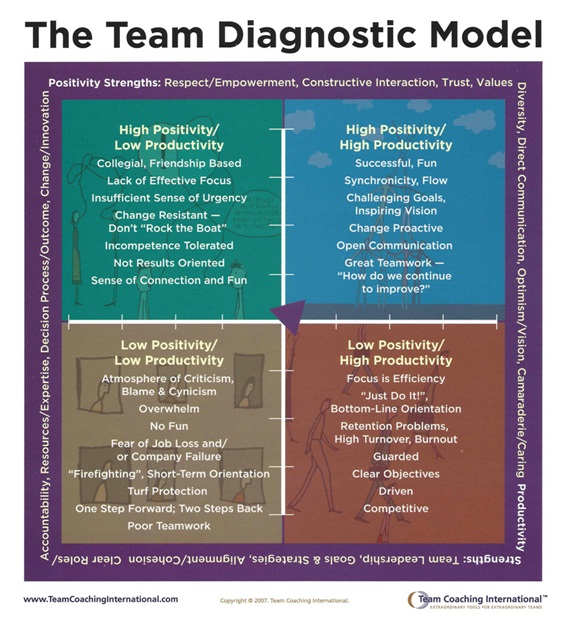
Research Paper By Stephen Miller
(Leadership Coach, GERMANY)
Leveraging my experience in international IT, project management and team leadership, I intend to build a significant portion of my coaching practice around coaching multinational project teams. To that end, I’ve been researching and training in various approaches to team development. In this paper I will compile some of my findings to provide the reader an overview of some of the options available and hopefully, to provide me with some clarity as to which team environment would benefit most from each model.
First each model will be introduced then compared at a high level. Following that, an overview of the models and description of each of their dimensions will be provided. Finally my opinions on their applicability to my target market will be presented.
Introduction to the Models
There are dozens of team development models and hundreds of books on the subject on the market today. The three that I selected to investigate over the past year or so were chosen because of prior connections to the organization that developed them. As I’ve delved deeper into the topic, I’ve run across many others, but needed to set boundaries in order to stay focused and able to consider putting any of them into practice.
Team Coaching International (TCI) provides a suite of four diagnostic tools built around one team model. TCI was formed in 2005 based on a team assessment developed in 2001 with Phillip Sandahl, co-author of the well-known Co-Active Coaching book, as one of its founders. Their website states “TCI has revitalized thousands of teams across the globe.”
Five Dysfunctions of a Team (5D) was introduced in 2002 by Patrick Lencioni, speaker and co-founder of The Table Group. Their website claims 5D has “become the world’s most definitive source on practical information for building teams.”
Finally, Better PracticeTM (BP) was introduced in 2015 by Joe Slater, a well-respected, successful former colleague of mine, based on his years of experience leading multinational project teams in Europe and the USA. Better Practice aims “to build reliable and sustainable project team performance.”
The table below compares some high-level aspects of the three models. The next section will go into more details of some of the elements.
| TCI | 5D | BP | |
| # Guiding principles | 4 | — | 10 |
| # Dimensions in model | 2 x 7 | 5 | 6 |
| Assessment | Proprietary | Proprietary | Third Party[1] |
| Assessment focus | Team | Team | Individual2 |
| Assessment validated | Yes | No | Yes[2] |
| Training or certification required | Yes | No | Yes |
| Coached entity | Team | Individual & team | Individual, then team |
Overview of the Models
This section will provide an overview of each of the models, looking closer at the aspects summarized in the above table.
Team Coaching International (TCI)
TCI’s Team DiagnosticTM model is built around these four guiding principle:
- Teams exist to produce results – they are in place to achieve specific outcomes.
- The team is a living system – it is an entity in and of itself and grows, changes, and adapts based on what is going on around and within it.
- Team members want to be on a high-performing team and want to contribute – people are wired to be in community and we would prefer to be part of a community that is making a difference.
- The team has within if the means to excel – just as a foundation in coaching is that clients are whole, resourceful and capable, the team as a unique entity holds these characteristics.
Using these principles as a foundation, the TCI model includes 14 factors that have been shown to contribute to team performance. These factors are divided between two dimensions – Productivity factors and Positivity factors. Productivity refers to the factors that support the work of the team. Positivity refers to the factors that create the environment the team operates in. When displayed in a grid, the quadrants create four atmospheres teams operate in as defined and characterized in the diagram below. Discussion of what it is like to work in these four atmospheres occurs early in a team coaching engagement. The goal of most teams is to be operating the majority of the time in the High Positivity / High Productivity quadrant.
 The factors which make up each dimension are as follows:
The factors which make up each dimension are as follows:
| Productivity | Positivity |
| Team Leadership
Resources Decision Making Proactivity Accountability Goals & Strategies Alignment (to mission and purpose) |
Trust
Respect Camaraderie Communication Constructive Interaction (conflict) Diversity Optimism |
There are four assessments available which measure the team on each of the factors. The two most widely-used are the Team Leader ViewTM (TLV, for just the team leader) and the Team DiagnosticTM Assessment (TDA, for each team member). The other assessments take 360o and organizational views of the team. Often the first step in a coaching engagement is looking at the team leader’s perspective through the TLV then extending the reach to the full team through the TDA.